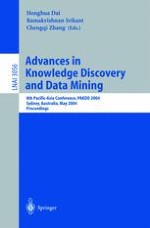ThePaci?c-AsiaConferenceonKnowledgeDiscoveryandDataMining(PAKDD) has been held every year since 1997. This year, the eighth in the series (PAKDD 2004) was held at Carlton Crest Hotel, Sydney, Australia, 26–28 May 2004. PAKDD is a leading international conference in the area of data mining. It p- vides an international forum for researchers and industry practitioners to share their new ideas, original research results and practical development experiences from all KDD-related areas including data mining, data warehousing, machine learning, databases, statistics, knowledge acquisition and automatic scienti?c discovery, data visualization, causal induction, and knowledge-based systems. The selection process this year was extremely competitive. We received 238 researchpapersfrom23countries,whichisthehighestinthehistoryofPAKDD, and re?ects the recognition of and interest in this conference. Each submitted research paper was reviewed by three members of the program committee. F- lowing this independent review, there were discussions among the reviewers, and when necessary, additional reviews from other experts were requested. A total of 50 papers were selected as full papers (21%), and another 31 were selected as short papers (13%), yielding a combined acceptance rate of approximately 34%. The conference accommodated both research papers presenting original - vestigation results and industrial papers reporting real data mining applications andsystemdevelopmentexperience.Theconferencealsoincludedthreetutorials on key technologies of knowledge discovery and data mining, and one workshop focusing on speci?c new challenges and emerging issues of knowledge discovery anddatamining.ThePAKDD2004programwasfurtherenhancedwithkeynote speeches by two outstanding researchers in the area of knowledge discovery and data mining: Philip Yu, Manager of Software Tools and Techniques, IBM T.J.
